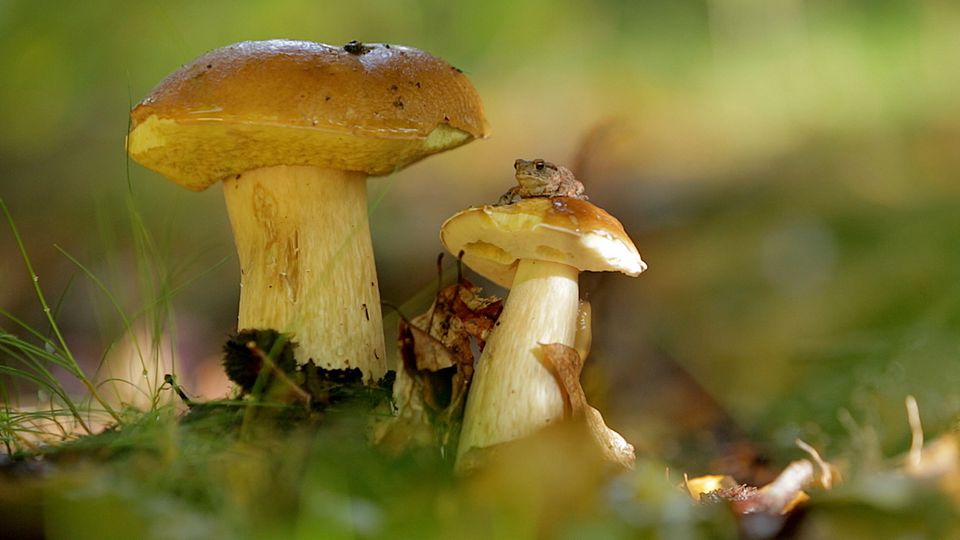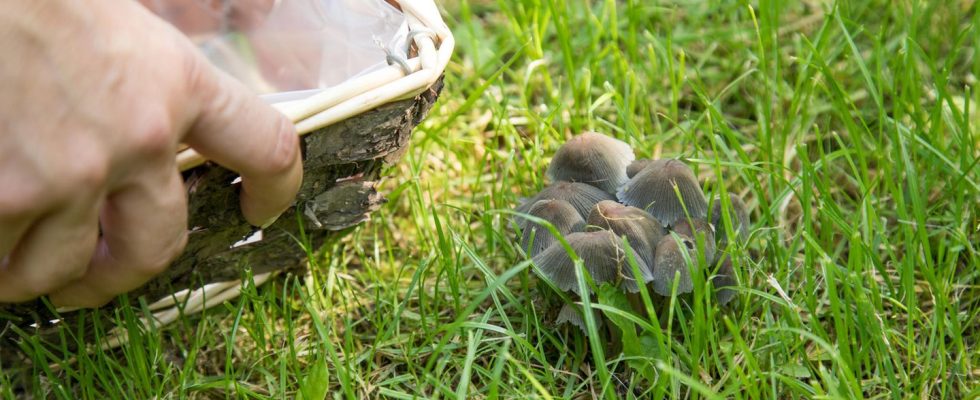Gardening tips
Mushrooms in the lawn: where they come from – and how they go again
Tiny fungal spores are enough to transform the lawn in the garden into a fungal landscape within a short time.
© Christin Klose / Picture Alliance
Hurray, hurray, autumn is here! And with it comes mushroom season. While lovers of porcini mushrooms, chestnuts and the like click their tongues, many gardeners are currently rolling their eyes. Because mushrooms have no place in your lawn. We’ll reveal how you can get rid of the little hat wearers.
Mushroom season is in full swing. In meadows and forests, red-footed boletus, porcini mushrooms, mushrooms, etc. are currently sprouting from the damp ground on a large scale. A festival for mushroom pickers and everyone who likes to get involved in autumn Cook mushrooms. But not everyone is happy about the distinctively scented creatures that cannot be assigned to either animals or plants. Mushrooms and their fruiting bodies sprouting from the ground are least welcome in and on the lawns of allotment gardeners. Mainly for aesthetic reasons.
In the following article we explain why fungi feel so comfortable in the lawn, how you can sustainably damage the robust root system and what measures can help keep fungi out of the garden.
How do fungi get into the lawn?
To understand how mushrooms spread, you should know that, from a botanical point of view, it is not the visible part that is the actual fungus, but rather the invisible part. The so-called mycelium is a network of roots that forms underground and sometimes spreads over a large area. The visible part, commonly called the mushroom, is the fruiting body and the part that later ends up in the pot or pan. It is vital for the fungus because it ensures that it can multiply. Tiny fungal spores stick to the underside of the hat and are blown by the wind or scattered in nature when collected. And this is exactly how the mushrooms and their fruiting bodies get into and onto the lawn of allotment gardens. In late summer and autumn, when it is still sufficiently warm but also very humid, the spores feel particularly comfortable in the meadow. They germinate and can spread under the lawn within one night. It usually doesn’t take too long until the fruit bodies sprout.
And the allotment gardeners themselves also contribute to the rapid multiplication of fungi in green areas. The spores attach themselves to the soles of shoes, the blades of the lawn mower or the scarifier and spread unnoticed.
What mushrooms commonly grow in gardens?
In addition to Bovists, so-called cap mushrooms are usually found in the nation’s allotment gardens. These include, among others, the Feldegerling and the meadow mushroom. But fertilizer insects and some types of scumbags also grow well in moist meadows. As solitary creatures, but also in groups, they emerge from the ground sometimes overnight in warm, humid autumn weather.

Gardeners find so-called stress mushrooms, such as Pythium, even less funny. The egg fungus lives parasitically, loves the blissful late summer temperatures and develops best in heavily compacted soil with a pH value that is too high (greater than 7.5). It is not visible through fruiting bodies. It attacks other plants from below at the roots, these die and what remains are ugly brown spots in the lawn that gradually spread.
Mushrooms in the lawn: dry out, pluck, cut out
When it comes to the fruiting bodies of the fungi, you have three options to rid your lawn of them.
- They wait for autumn and winter. As soon as the grass area dries out properly, the fruiting bodies disappear on their own.
- They pluck the fruiting bodies carefully and, if possible, above the ground and dispose of the waste in the household waste so that the spores do not spread further. Don’t forget to wash your hands thoroughly!
- They generously cut out the area around the fruiting bodies. This waste also has no place in the compost and belongs in the residual waste. You can now reseed lawn on the bare areas.
Important: Beheading the fruiting bodies with a lawnmower is the worst possible tactic. The spores are distributed throughout the garden and have exactly the opposite effect.
Strengthen lawns with nitrogen, potassium and phosphorus
If you notice an increasing number of mushrooms with fruiting bodies on your lawn, you may have another problem. The soil may be suffering from a lack of nutrients. In addition, waterlogging could play into the hands of the fungi. This may be caused by watering too frequently and for too long. So the solution is quite simple. Skip watering every now and then – and give your lawn a generous helping Long-term fertilizer and some Soil activators. The nitrogen contained in the fertilizer promotes the growth of the grass, potassium and phosphorus ensure resistance and strengthen the roots. The minerals and algae in the activator slow down fungal growth and stimulate soil life.
Tip: When reseeding the lawn, make sure that you carefully dig up the soil and pick up any plant debris. Forgotten dead wood could stimulate fungal growth later.
Stress fungi in the garden: recognizing and combating them
So-called stress fungi spread preferentially at very high day and night temperatures, combined with high humidity. Soil compaction and excessive fertilization, for example with nitrogen, also play into the hands of the fungi. Stress fungi can easily be confused with drought damage. If you pluck a single plant from the lawn, this is very easy if the lawn is infested with stress fungi. As a rule, the brownish root collar tears off. Under ideal conditions, small patches quickly develop into larger areas. The following measures help to prevent stress fungi or get rid of them again.
- Watering only in the morning hours
- Regular scarifying
- Even supply of nutrients
- Regular checking of the pH value
- Pay attention to the seed quantity when reseeding
Essentially, you have to deprive the mushrooms of exactly what they need to grow. Ditch them. Use the scarifier to ensure that the soil is durable and well ventilated. Give the lawn a spray of fertilizer every now and then (but not too much) and, especially now in autumn, make sure that after mowing the lawn, you consistently dispose of the clippings and fallen leaves.
Sources: My garden world; “ndr.de”; lawndiseases.com
You might also be interested in:
This text was first published in September 2020.
This article contains so-called affiliate links. Further information are available here.



